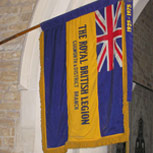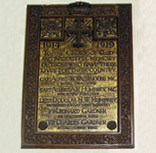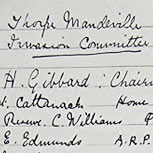
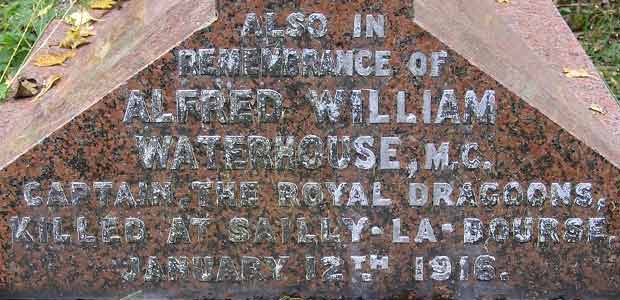
The Battle of Danes Moor
in 1469 was only a few yards north-west from Thorpe in the adjoining parish
of Edgcote. We can only speculate about the impact on the village. One account
refers to the likelihood of the rebel army advancing from Thorpe Mandeville
and the death of 5,000 men during the battle.
The earliest records of military influences on Thorpe are found in the Militia
Lists. The militia was a county-based force of men created as a second line
of defence after the regular army to defend the country from invasion or rebellion.
Initially property owners were responsible for providing men who were required
to serve and muster for training several times a year:
• The 1545-6 Musters book refers to Thorpe providing one archer and
two bilmen.
• The 1559 Militia List refers to Mr. Gyfford being charged to “furnyshe
a pykeman on foote & the rest of the town an archer.”
• The 1583 Militia List required Mr. Kirton to supply a light horseman.
• The trained band schedule of 1613 named five men from the parish.
The lord of the manor during the Civil War was Thomas Kirton. His wife, Mary,
was a first cousin of Oliver Cromwell and the 18th century historian Bridges
refers to the manor being garrisoned by Cromwell with earthworks being thrown
up as protection against the Royalists. However, this undated reference may
conflict with the account leading up to the nearby Battle of Cropredy Bridge
in June 1644. According to Richard Symonds, who served in the king’s
troop, King Charles stayed overnight at the next village of Culworth, his
troops being quartered at Thorpe’s manor house.
During the great siege of Banbury in 1646 by the parliamentarian Colonel Whalley
there is an account which refers to the difficulties in creating the siege
and “That they may be the better proceed in it, and have better accommodations
in case any disturbance should be, they have begun and are going fast on to
fortifie a house at Thorp Mandevil …”
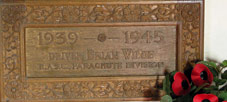
|
| Church 1939-45 war memorial |
The Militia List of 1762
details thirteen men from the parish advising that it is “a true list
of all the men’s names in the parish of Thropmandivile between the ages
of 18 and 45,” The list included “Edward Golby – grazier
and ale seller”. Entries were crossed out for a deaf servant and three
labourers with more than five children.
Edward Linnell, innkeeper at the Three Conies, was responsible for the 1781
list.
Memorials in the church
record the loss of five lives from the First World War, 1914 -18 and one life
from the Second World War, 1939-45.
Army personnel with the 4th/7th Dragoon Guards, Royal Amoured Corps were billeted
throughout the parish during the 1939-45 war. One of the officers in Thorpe
was Bernard Weatherill who later became Speaker of the House of Commons and
subsequently a Life Peer. He was billeted with Ted Edmunds and his family
at the Warren in 1941.
The 4th/7th Dragoon Guards was a tank regiment. Tanks were stationed at The
Hill and concrete reinforcements to the lane were necessary and are still
evident. A subsequent owner of The Hill thought that he had acquired a disused
tennis court, only to find concrete hard-standing covered by moss and weeds…
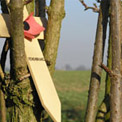 |
| Air crash remembrance poppy, 2008 |
In 1943 a Wellington bomber
from the RAF’s wartime Operational Training Unit at Chipping Warden
hit a tree on Thorpe’s northern boundary with Culworth. It crashed into
a field in Culworth parish with the loss of five lives.
A parish invasion committee was formed in 1942 and defence plans were considered.
These were revised in 1943 when the committee was informed that Thorpe would
not be a defended place. Nevertheless it was still necessary to designate
the Manor as the first-aid post, the Court as the emergency food store and
a loose box at the Three Conies as a temporary mortuary. The church bells
were to be rung in case of invasion…
(Main photograph: Memorial
in Thorpe Mandeville churchyard, 2008)
